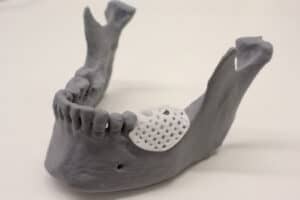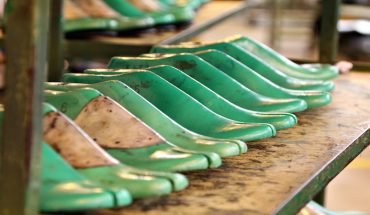3D Printing for Jaw Bone Reconstruction – Clinicians have successfully used custom-made 3D printed bone scaffolds, printed on-site at The University of Queensland, to rebuild part of a man’s jawbone.
Professor Saso Ivanovski from UQ’s School of Dentistry, who led the clinical trial, said the case demonstrated the safe and effective use of the technology which uses biocompatible material – eliminating the need for secondary surgery to remove the scaffold.
“In this case, the scaffold supported and encouraged new bone to grow in the jaw of a 46 year-old man, allowing a
dental implant with a new tooth to be securely inserted,” Professor Ivanovski said.
“The bone scaffolds are custom designed for the patient, effectively regenerate jaw bone and are completely resorbable, so there is no need for additional surgery to remove them.”
Since this initial success, more polycaprolactone (PCL) scaffolds have been printed at UQ’s Oral Health Centre and used in dental reconstructive surgery on a further 9 patients.
Lead biomedical engineer Dr Reuben Staples said the research highlights the huge potential of 3D-printing in personalised dental reconstruction.

A model demonstrating where the 3D printed scaffold can be placed on the jaw. Image: UQ.
“Our team is the first in Australia to locally manufacture university-developed 3D printed bone scaffold implants for dental reconstruction in human trials using our certified Quality Management System,” Dr Staples said.
“It is compliant with the Australian regulatory requirements.
“Because the medical grade synthetic polymer used is more cost effective than currently available non-resorbable metallic commercial alternatives, this is a significant step forward in how 3D printing can be used to create affordable, safe and effective bone implant solutions to reconstruct jawbones and teeth for people in need.
“There is still more to be done in this field, but it’s exciting to see this success.”
The UQ team will now expand the trial to work with clinicians from around Australia and Spain to optimise the scaffold design so that it can be widely available for patients.
The research is published in Clinical Oral Implants Research.
- Combination of drugs could prevent thousands of heart attacks - 21st April 2025
- UQ Study Links Poor Teen Diets to Heavy Social Media Use - 21st April 2025
- Gut microbiome could delay onset of type 1 diabetes - 3rd April 2025






